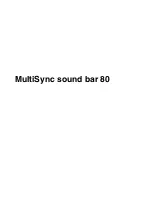
8
NHT
iC3 ARC In-Ceiling Loudspeaker Installation Guide
Installation: Existing Construction (retrofitting finished ceilings)
This multi-step process begins by identifying a location in your ceiling for the speaker (always keeping a plan B in mind). Somehow
you’ll need to get speaker wire to that spot. Using a stud-finder or something you will make sure there are no obstructions behind
your intended speaker location. Using the enclosed cutout template you will mark the hole and cut a clean hole using a rotary cutter,
sheetrock or keyhole saw. After you have found and connected the speaker wire you will mount the speaker in the hole and snap on
the magnetic grill. It’s usually not as easy as this sounds and you should once again consider hiring a pro installer.
Warning: Exercise caution when drilling into existing ceilings. Do not drill through electrical wires, pipes, drains, conduits, heating or
air conditioning ducts or structural wood or metal support members. If you feel resistance while drilling, you should stop immediately.
Do not install the speaker into a drop ceiling (T-Bar) or soft ceiling without a proper backing board to spread the load, as this type of
construction will not support its weight.
You will not need the iCB6 pre-construction bracket nor will you be able to install it if you wanted to. The speaker is designed to
mount securely without it (assuming you do everything right).
Tools You’ll Need:
#2 Philips screwdriver
Pencil
Tape measure
Utility knife or keyhole saw
Safety goggles
Dust mask
Protective gloves
A ladder
Electric drill with #2 Philips bit
Band-aids
. Using a “stud finder” or the “knocking” method, locate the ceiling joists in the ceiling area where you wish to mount the speaker.
The speaker will be mounted between adjacent joists, no closer than two inches from either joist.
2. Determine that there are no obstructions above the desired cutout area. This may be accomplished by drilling a hole in the center
of the cutout area and using an “L” shaped piece of metal (like a bent coat hanger wire) to “feel around” above the ceiling. If you
discover an obstruction, fill the hole with patching compound and try another location (plan B).
3. If no obstructions are found above the ceiling, use the supplied cutout template and a pencil to draw an outline of the area to be
cut out. Make sure you are using the right template. Begin by drilling a hole on the inside of the circle with a /4” bit, then cut the





























